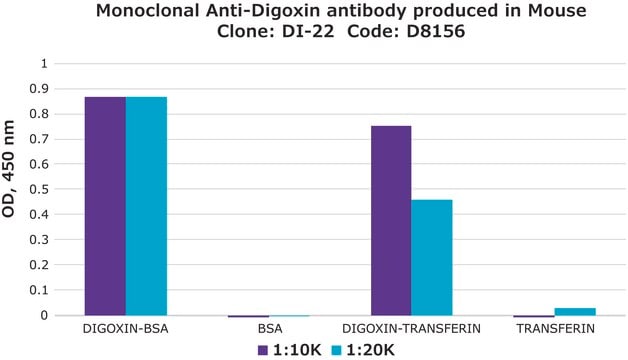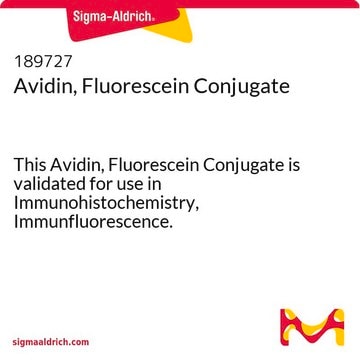11207750910
Roche
Anti-Digoxigenin-Rhodamine, Fab fragments
from sheep
Synonym(s):
anti-digoxigenin, digoxigenin
Sign Into View Organizational & Contract Pricing
All Photos(1)
About This Item
UNSPSC Code:
12352203
Recommended Products
biological source
sheep
Quality Level
conjugate
rhodamine conjugate
antibody form
purified antibody
antibody product type
primary antibodies
clone
polyclonal
form
lyophilized (clear, red solution after reconstitution)
packaging
pkg of 200 μg
manufacturer/tradename
Roche
isotype
IgG
storage temp.
2-8°C
General description
Digoxigenin is a hapten, useful in labeling nucleic acids and in detection systems. This product contains Fab fragments from polyclonal anti-digoxigenin antibodies, conjugated to rhodamine.
Specificity
Polyclonal antibodies from sheep show 100% reactivity with digoxigenin and digoxin, but no cross-reactivity with other steroids, such as human estrogens (e.g., estradiol) or androgens (e.g., testosterone).
Application
Use Anti-Digoxigenin-Rhodamine, Fab fragments for the detection of digoxigenin-labeled compounds using:
- Digoxigenin-labeled sugars in glycoconjugate research
- Fluorescent in situ hybridization (FISH)
- Immunohistocytochemistry
- In situ hybridization
- DNA fiber assay
Preparation Note
After immunization with digoxigenin, sheep IgG was purified by ion-exchange chromatography, and the specific IgG was isolated by immunosorption. The Fab fragments obtained by papain digestion were purified by gel filtration, conjugated to the specific label, and stabilized in buffer.
Working concentration: Working concentration of conjugate depends on application and substrate. The following concentrations should be taken as a guideline: Detection of digoxigenin-labeled sugars in glycoconjugates: 20 to 50 μg/ml
Working solution: PBS, 0.5% bovine serum albumin (w/v), pH 7.4.
1% Blocking reagent (w/v), 1 to 5% heat inactivated fetal calf serum (v/v) or sheep normal serum can be used for reduction of unspecific binding. Furthermore pH can be increased up to pH 8.5 to 9.0.
Storage conditions (working solution): Always prepare fresh!
Working concentration: Working concentration of conjugate depends on application and substrate. The following concentrations should be taken as a guideline: Detection of digoxigenin-labeled sugars in glycoconjugates: 20 to 50 μg/ml
- Fluorescent in situ hybridization (FISH): 1 to 20 μg/ml
- Immunohistocytochemistry: 20 to 50 μg/ml
- In situ hybridization: 20 to 50 μg/ml
Working solution: PBS, 0.5% bovine serum albumin (w/v), pH 7.4.
1% Blocking reagent (w/v), 1 to 5% heat inactivated fetal calf serum (v/v) or sheep normal serum can be used for reduction of unspecific binding. Furthermore pH can be increased up to pH 8.5 to 9.0.
Storage conditions (working solution): Always prepare fresh!
Reconstitution
Add 1 ml double-distilled water to a final concentration of 200 μg/ml.
Other Notes
For life science research only. Not for use in diagnostic procedures.
Not finding the right product?
Try our Product Selector Tool.
Signal Word
Warning
Hazard Statements
Precautionary Statements
Hazard Classifications
Aquatic Chronic 3 - Skin Sens. 1
Storage Class Code
11 - Combustible Solids
WGK
WGK 2
Flash Point(F)
does not flash
Flash Point(C)
does not flash
Choose from one of the most recent versions:
Already Own This Product?
Find documentation for the products that you have recently purchased in the Document Library.
Customers Also Viewed
Camila A Quercia et al.
Comparative cytogenetics, 14(1), 61-74 (2020-02-12)
South American frogs of the genus Eupsophus Fitzinger, 1843 comprise 10 species. Two of them, Eupsophus vertebralis Grandison, 1961 and E. emiliopugini Formas, 1989 belong to the Eupsophus vertebralis group, exhibiting 2n = 28. Fundamental number differences between these species
Yansen Ma et al.
FEBS letters, 587(10), 1489-1495 (2013-03-29)
One of the major challenges in stem cell research is to decipher the controlling mechanisms/genes of stem cell homeostasis. Through an RNAi mediated genetic screen of living animals, we identified an evolutionarily conserved histone acetyltransferase Atac2 as a novel regulator
Spencer W Luebben et al.
Nucleic acids research, 41(22), 10283-10297 (2013-09-06)
HELQ is a superfamily 2 DNA helicase found in archaea and metazoans. It has been implicated in processing stalled replication forks and in repairing DNA double-strand breaks and inter-strand crosslinks. Though previous studies have suggested the possibility that HELQ is
Galina Pendinen et al.
Genome, 51(9), 714-720 (2008-09-06)
Thirty-six percent of the wild potato (Solanum L. section Petota Dumort.) species are polyploid, and about half of the polyploids are tetraploid species (2n = 4x = 48). Determination of the type of polyploidy and development of the genome concept
A Pauciullo et al.
Theriogenology, 77(3), 675-683 (2011-11-08)
In vitro-matured metaphase II (MII) oocytes with corresponding first polar bodies (I pb) from two indigenous cattle (Bos taurus) breeds have been investigated to provide specific data upon the incidence of aneuploidy. A total of 165 and 140 in vitro-matured
Our team of scientists has experience in all areas of research including Life Science, Material Science, Chemical Synthesis, Chromatography, Analytical and many others.
Contact Technical Service






